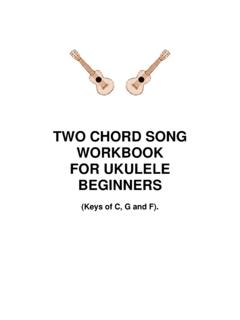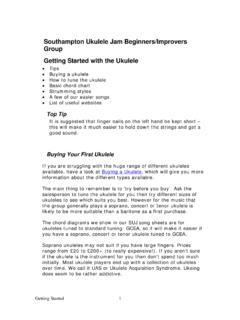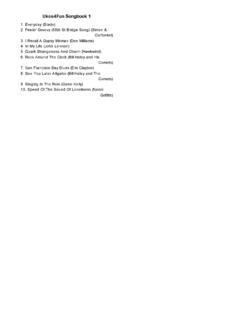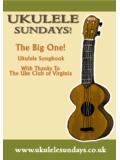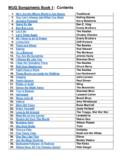Transcription of The Ukulele Bedford guide to Chords, chord …
1 The Ukulele Bedford guide to Chords, chord shapes and sort of cheating There are often simpler ways of moving between chords than a glance of the chord diagrams may tell you, so this session aims to give you some of the principles behind making your chord changes easier, along with examples to practice. I could just give you a whole heap of tips for changing between chords, but I think it will be more use if I put them into a context and then a system. This means that when you are struggling with a change on your own, you have some principles that may help. To do this we are going to start at the very beginning. Rumour has it that it s a very good place to start. The very basics Notes Your Ukulele has four strings, all of which have frets allowing you to play every note on each of your four strings in the same order.
2 They just start as the open string in different places. If you play, typically, three notes together, you have a chord . If you can comfortably reach the first five frets, you have well over 1,000 combinations of three different notes you could play at once. That s a lot of chords, but many are the same. Notes an octave apart sound different but are given the same letter. So an open A string plays the note A. But fretted on the 12th fret it also plays an A. As does the fifth fret on the E string, the ninth fret on the C string and the second fret on the G string. Do they sound the same? Broadly they do, if they are in the same octave, but the length of the string also affects the quality of the sound.
3 But if I sing an A (and get it right!) it would sound very different from most women singing an A. Same note, different voice. Chords, chord inversions and chord shapes or patterns Chords are notes played together, but not in just any combination of three. The basic building block of a chord is the triad, a stack of three notes. Think of Do Re Mi Fa Soh La Te Do, as in The Sound of Music. Do, Mi, Soh played together make a chord , and if Do is a C note, Mi is an E and Soh is a G. We call the first note the root note, which gives the chord its name, C in this case. E is called the third and G is the fifth, simply by counting through the scale. This means that on a Ukulele with four strings we can play CEG on three of them and double up to play another C, E or G on the fourth and we will have a C chord .
4 (Note that if our root note, our Do, was a G, our third and fifth would be B and D respectively musicians often talk numbers rather than notes because then they can be relevant to all keys. Think of the key as simply the chord that a piece of music is centred around. Most of our music is in the key of C, either originally or transposed that way to make it easier to play on Ukulele ). Strum the open strings (0000 always number from the fourth string, as you would storeys in a building) and you have the chord C6 (also called Am7, but that s for another day), which comprises four different notes G C E and A. Play a C chord (0003) and you are playing G C E and C.
5 That s three notes and is more typical of what we play. The two different C notes in the same chord don t affect the name of the chord , but they may affect its sound. The C would sound stronger within the chord than if the G were doubled. So: 0,0,0,3 = GCEC. But 0,0,0,10 = GCEG. And 0,0,0,12 = GCEC. And 0,0,3,7 = GCGE. And the barre chord 5433=CEGC. These variations all count as C major chords. Try them now. They sound different, don t they? But, they all work with other C major chords. Any combination of the three notes that make a chord (the root, C, the third, E and the fifth, G) can be used in any circumstance. This is also why we can play low and high G with the same chords in the same group.
6 These different fingerings for the same chord can result in a different note in the triad being the lowest sounding. These variants are called chord inversions. However, even with the same inversion, there are lots of different finger patterns or chord shapes that result in the same sound because it depends on which finger you use on which fret of which string to make the note, and as we saw in the first paragraph, every string has every note. There are hundreds of ways of playing CEG on the Ukulele , and all this preamble is useful, as we will see now when you want to cheat. Using this knowledge Let s take a chord like B7. It comprises the four notes A B D# F#. That means we can play it as a barre chord 2322 (A D# F# B).
7 But also means 4320 (B D# F# A) works because as we strum the notes are playing together. Moving between different chord patterns and inversions to move between different named chords can make it much easier on your fingers and your brain, and they can sound better. (This is part of the basis for chord -melody playing that James Hill uses so effectively for another day.) Try them now as muted chords. Barre chord for a bar and then the other way for a bar. Hear how the A string rings out more with the second version. When you need a barre chord , eg for bounce, you play the first version. When you need to shift between E minor and B7 you play the second. This means that these patterns work differently because of the context of the other chords that come before and after them, leading to our next principle: Think ahead - the system If you just treat each chord as you find it or as it says in the chord charts, you will find it more tiring, harder and more confusing than if you know what s coming up next.
8 Try to look a couple of chords ahead of your playing, so that you can get your fingers in the right places sooner. Moving between chords is easier if you don t have to move all your fingers at once, or if you can keep the same hand shape, or if you can slide or pivot your fingers between the chords. This is the basis of faster, more assured movements between chords and is what we are going to practice now. It s also really useful if you keep changing between different sizes of Ukulele , like I do. It helps reduce all those thuds and buzzes! To do this, you are looking for anchors (there may be a more official term). Anchors take four forms: 1. Hand anchors 2. Finger guides 3.
9 Finger pivots 4. Finger slides 1 Hand anchors Barre chords are the ultimate anchor system, and work by keeping your hand in the same position and moving from the elbow. Think of the barre chords for C -> B -> Bb ->C Most of the movement comes from the elbow, The hand is locked. We know that from last month s session. Hand anchors tend to involve moving from the wrist rather than the elbow. Think of how B7 (4320) -> Em (0432)-> B7 (4320) works Versus B7 (2322) -> Em -> (0432) -> B7 (2322). Or Em7 (0202)- > D7 (2020)-> Em7 (0202) Versus Em7(0202) -> D7 (2223) -> Em7 (0202) It s much easier if you employ your hand anchor to shift between the chords. And you do that by knowing the different patterns for B7 and D7 and by looking ahead to see what combination of chords is coming up.
10 2 Finger guides The hardest chords to make are where you have to lift all four fingers from the fretboard at once, change their position relative to each other and plonk them down in the right place, and then do it again for the next beat. Tricky. (This is why I don t like Am7 or C6 played 0000 the next chord would have to involve all fingers changing. Instead, it sometimes helps to play Am7 as 2030, giving you scope to use this system.) If you can keep at least one finger in place, and know which one it is before you need it, that will make life much easier. For example: Try C (0003)-> Cdim (2323). Start with your ring finger on C .. horrid. You may even find yourself bringing your thumb over the top.
